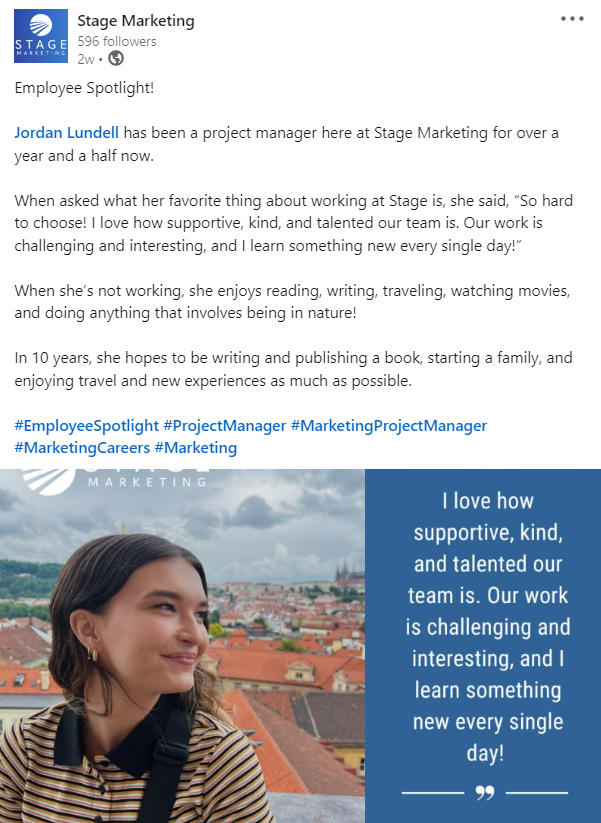Have you ever seen Simon Sinek’s TEDx talk “How great leaders inspire action”? Chances are you have since this talk has racked up over 69 million views—a number many marketing professionals would give their left arm for! Founder of The Optimism Company, Sinek is a living, breathing example of how to use an inspirational marketing message strategy. He also covers it in his TEDx talk:
“If Apple were like everyone else,” he said, “a marketing message from them might sound like this: ‘We make great computers. They’re beautifully designed, simple to use, and user-friendly. Want to buy one?’ ‘Meh.’ That’s how most of us communicate. . . . It’s uninspiring.”
He goes on to say, “Here’s how Apple actually communicates. ‘We believe in challenging the status quo. We believe in thinking differently. The way we challenge the status quo is by making our products beautifully designed, simple to use, and user-friendly. We just happen to make great computers. Want to buy one?’ Totally different, right? You’re ready to buy a computer from me. I just reversed the order of the information. What it proves to us is that people don’t buy what you do; people buy why you do it.”
Crafting an inspiring marketing message is all about your why. But what does that actually mean?
In this article, we’ll cover a few topics to help you find your why and use it to create a marketing message strategy that really works. Here are the key takeaways:
- A marketing message is the words and phrases you use to communicate with your audience.
- You can get started on creating your marketing messaging strategy by aligning with your company’s overall goals.
- There are several different approaches you can take. The best one for you depends on your competitors, your pain points, and your audience.
- Inspiration is the opposite of manipulation. But in marketing, manipulation isn’t necessarily a bad thing!
What’s a Marketing Message?
Marketing messaging, marketing messages—what exactly do these refer to? Overall, your messaging is how you communicate with your customers and highlight the value of your product or service as well as what you value as a company.
“In short, messaging covers both a brand’s literal language and the subtext of their ads,” says Brent Barnhart at Sprout Social. “Your approach to messaging impacts pretty much every corner of your business.”
Your messaging shows up in social media posts, ad copy, website copy, email campaigns, and calls to action.
“Keep in mind the distinction between your marketing messaging and your brand voice,” Barnhart says. “The former refers to the big-picture message you want to convey to customers, while the latter represents the tone and attitude you adopt while doing so.”
Looking a little closer, marketing messages are the actual words and phrases you use and the feelings they elicit in your audience. To give you a better idea, here are some examples of marketing messages:
Social Media Posts: Employee spotlights are a great way to showcase your company culture and show what you value. Here is an employee spotlight post we recently shared on LinkedIn.
Ads: In this one-minute ad, Ancestry.com combined music, images, and evocative sound bytes to highlight the power of knowing who your ancestors are.
Website Copy: The copy on the PathologyWatch homepage focuses on the positive effects in store for you when you use their service.
Calls to Action (CTAs): Community Action Services features their CTAs front and center in their marketing collateral. These CTAs don’t just invite you to do something: They tell you why you are needed and how you will be helping if you take action.
How Do I Start Creating a Marketing Message?
Marketing messaging touches everything you do, and it can be overwhelming! So here are five steps to get you started:
1. Consider your company’s overall goals. These goals should guide every department in the company, including the marketing department. The marketing department should be involved in the operational planning process from the beginning so that they know how to craft marketing goals and marketing messaging in a way that aligns with the company as a whole.
2. Know your target audience and what they value. Before you consider the needs of your product or brand, consider what strategies will best deliver value for your customers’ unique wants and needs. This value could be financial ROI or nonmonetary benefits. This approach is called “added value marketing,” and it makes it clear what your marketing message should be.
3. Determine your why and keep your message simple. Every time you position yourself in front of the public, your values should be obvious. You can only do this effectively if you know what your values are! Identify what is most important to you, and keep those values top of mind when you craft marketing messages.
4. Differentiate your product or service to stand out among the competition. For your marketing messaging to stand out authentically, you need to stand out. So ask yourself, “What makes us unique?” “What about our offering is better than anyone else in the industry?” “What do we provide that no one else provides?” Highlight your unique qualities in your marketing messages for better brand identity and awareness.
5. Be consistent. “The benefits of creating consistent messaging is that it encourages connection with the customer and builds trust in your brand,” says Megan Ross, digital marketing manager at Stage Marketing. “When you think about the impact repetition has on brand recognition, consistency is pivotal in positioning your brand for that response.”
Do Different Industries Require Different Messaging?
Depending on your business, there may be a certain approach to messaging that you should take. Let’s first talk about a few different messaging approaches that you can take.
Messaging Approaches
Emotional: Emotion-based messaging appeals to the emotions rather than to straight facts. Emotions create preferences, helping us make decisions. In fact, several studies of people who have damaged connections between the “thinking” and “emotional” areas of the brain have shown that emotions are crucial to our decision-making. Help your customers make decisions (and decide on you!) by appealing to their emotions.
Unique Selling Proposition: To stand out among your competitors, highlight what makes you unique. A great example of this was the Domino’s Pizza offer of “fresh hot pizza delivered to your door in 30 minutes or less or it’s free.” This unique and specific offering benefited customers either way, helping Domino’s stand out in a highly competitive space.
Generic: “Generic” doesn’t mean blending into everyone else—it means you market the category of your offering rather than your specific product. For example, a pediatrician’s office might focus on the benefits of seeing a pediatrician over a family doctor rather than what makes their office better than another pediatrician’s office.
Positioning: What makes you the best in comparison to the competition? Are you #1 in customer service? A five-year category award-winner? Best-rated by the BBB? This messaging strategy uses third-party determinations to point out why you are the best.
Brand Image: Similar to generic messaging, brand image doesn’t necessarily focus on a product. Instead, it focuses on your brand’s personality. This Chanel No. 5 ad featuring Marion Cotillard is a good example. The bulk of the ad uses music, acting, and imagery to establish Chanel’s personality—sophisticated, sensual, playful—before it introduces the product in the last few seconds.
Preemptive: This approach is all about timing. You make a claim about your product—a claim that your competitors could also make honestly—but you make it first. For example, Listerine claimed that using their breath strips would be like covering up a crime scene. The preemptive strategy requires competitor research to ensure that your competitors’ marketing and advertising efforts don’t already feature the claim you would like to make.
How to Choose a Messaging Approach
So, how might these approaches apply industry to industry? The answer is “it depends.”
Start by researching what your competitors are doing. Is their messaging effective, and could you take a similar approach? Is their messaging missing something that you could use to better draw in clients? Perhaps you’re a tech company and you observe that your competitors do a really good job showcasing their brand image. You could reexamine your brand’s personality, define it, and launch a campaign that better illustrates why customers should choose you (because you’re forward-thinking, ethical, and customer-centric, for example).
Then examine your marketing pain points and see how a shift in your approach to messaging could help. For example, let’s say you’re a healthcare company, and your primary messaging approach is “emotional,” but your problem is that not enough people even know your specialty exists. Like the pediatrician in the “generic” example above, you might need to try marketing your category rather than your specific business.
Conducting market research can also help refine your messaging strategy. Maybe you’re in retail and your market research reveals that consumers are just as likely to buy from you as from your most similar competitor. That could indicate that it’s time to better showcase your unique selling proposition or your positioning as an award-winning business.
How Do I Avoid Being Manipulative in My Messaging?
In marketing, manipulation refers to short-term strategies that get your customers to act quickly. This could be dropping your prices, having a promotion, or using scare tactics (e.g., “9 out of 10 dogs have a horrible, undiagnosed disease. Buy our dog DNA kit NOW or you might be saying goodbye to Spot!”). Sometimes, these strategies are necessary to draw attention and meet your short-term goals. But they can get expensive over time, may not be the most ethical, and don’t tend to lead to long-term customer relationships.
A better long-term marketing message strategy is inspiration. As Sinek says in his TEDx talk, “People don’t buy what you do. They buy why you do it.” As you prioritize your why—your cause, your beliefs—in your messaging strategy, you’ll attract customers who have the same values as you. Then, when you hold promotions or launch a campaign, they will be grounded in ideas that really matter, not just your desire to get leads.
There’s no time like the present to create a marketing message strategy based on inspiration. It’s easier than you think to get started, and there are a few different approaches you can take depending on your industry and goals. The most important thing is to figure out your why so that you can market yourself authentically and connect with people who will become lifelong customers.
At Stage Marketing, we exist to help you succeed. Visit our website to learn more about how we can help you craft a marketing messaging strategy that will help you to generate leads and elevate your brand.




